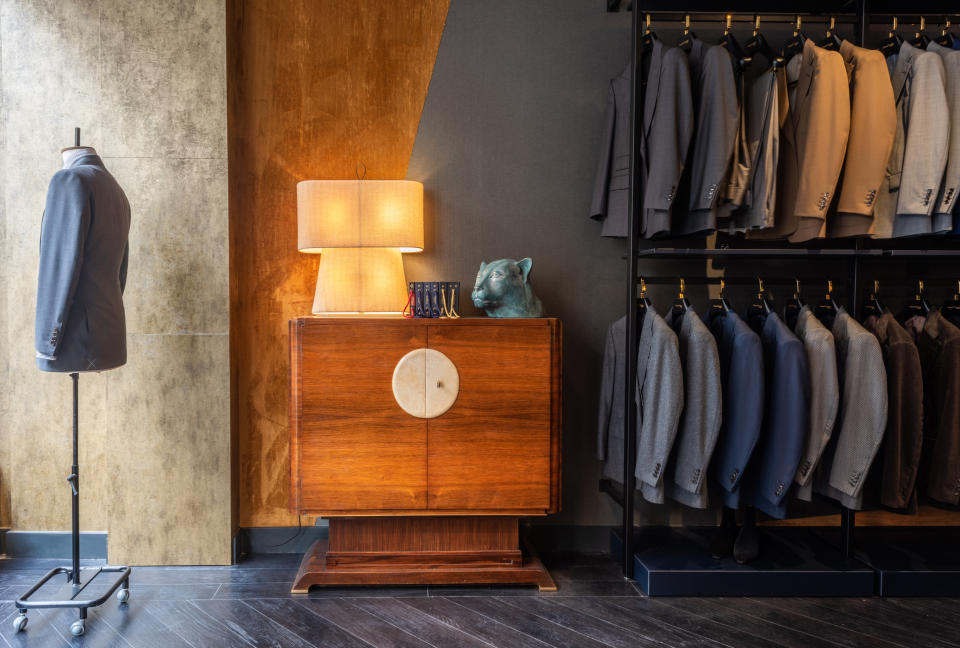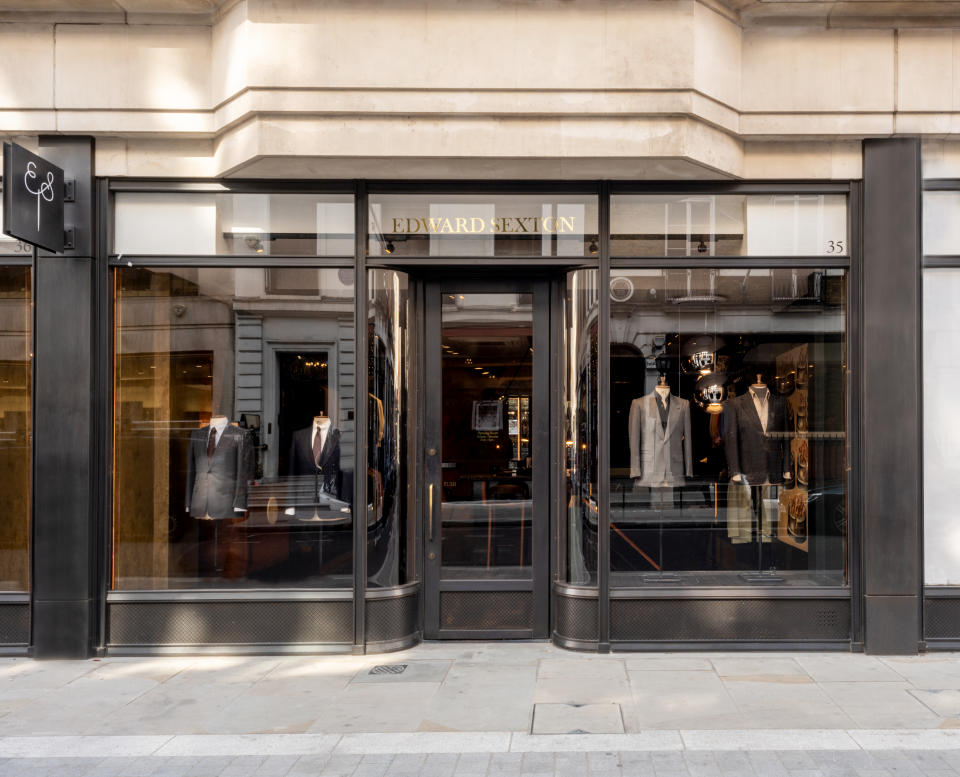Savile Row Tailor Edward Sexton Dies at 80

LONDON — Edward Sexton, the tailor who dressed The Beatles and shook up Savile Row with his bright colors and counterculture flair, has died at age 80 following a short illness.
Sexton famously set up shop with business partner Tommy Nutter in 1969, bringing an air of rebellious glamor to a street long synonymous with strictly tailored pinstriped or dark suits, starched shirts and tradition.
More from WWD
Margherita Maccapani Missoni Readies Her First Retail Launch With Browns
Craig Green Reveals His Softer Side in Milestone 'Double' Collection
Time for Unilever to 'Raise Its Game' Says New CEO Hein Schumacher
Sexton spoke to the press, decorated his windows with bold statement jackets and dressed three of The Beatles for the “Abbey Road” jacket cover. Sexton would continue to make suits for Paul McCartney long after he left the band.
Stella McCartney later worked as an apprentice in his shop, and Sexton’s style has long influenced her collections.
Sexton helped McCartney with her Central Saint Martins graduate fashion show, which was modeled by Kate Moss, Naomi Campbell and Yasmin Le Bon, and she repaid the favor by tapping him as a consultant for Chloé when she was creative director there.
“Edward was a true talent and one of the few, true pattern-cutting Savile Row creatives who had a business founded in craft and technical ability. So few have that or have ever had it. Sadly, it’s a dying trade,” McCartney told WWD.
“My years spent as an apprentice to Edward were some of the most memorable and valuable in my career. He made my Saint Martins degree suits, and Naomi has never looked cooler. He was so much fun, a cheeky ‘live life in the moment’ man. What a sad day for British bespoke tailoring. Rock on Edward. I will never forget you,” she said.
Sean Dixon, cofounder of Richard James, a neighbor on Savile Row, said that he and James “always thought of Sexton as the original tailor to the stars, and very much part of the old school Savile Row heritage. A truly great cutter.”
A fast-talking, impeccably mannered man whose suits and shirts miraculously never seemed to be a centimeter out of place or bear even a hint of a wrinkle, Sexton was passionate about his craft — talking fabrics and cuts like an engineer describing a new model of supersonic airplane. He would almost swoon over a fabric held in his hands, and smile proudly as he displayed the workmanship of one of his suits.
Sexton’s and Nutter’s Savile Row store closed for good in 1990, although Sexton returned to the street several times subsequently, the most recent being last year when he opened a shop at number 35.
“Edward always used to say that [Savile Row] was quite gossipy because it’s a small community and everyone knows each other, but actually what we have felt is that everyone is so happy to have us returning,” Dominic Sebag-Montefiore, creative director of the brand, told WWD last October.
Sexton and Sebag-Montefiore preserved the original maverick spirit of the shop, updating it for the 21st century.
“We’ve got an edge, but we’re still an establishment, the same as The Beatles and Rolling Stones. It’s classic British quality craft, but rebellious by knowing — and choosing — to break the rules in a meaningful way,” added Sebag-Montefiore.
He said that since Sexton landed back on Savile Row the house had noticed that clients have been finding joy in dressing up. They were ordering velvet jackets in different colors and asking for silk shirts, and separates with interesting textures.

Sexton was born in Dagenham, east London, to a family familiar with a needle and thread. His uncles, aunts and cousins all worked as tailors and seamstresses.
He learned his trade early, leaving school at the age of 15 to work with Lew Rose in a workshop on the Commercial Road in London’s East End. His father had advised him to pick a trade, as there would “always be work for people with practical skills.”
There, Sexton trained as a cutter, learning to make bespoke garments before heading west to Savile Row, where he worked with the equestrian tailor Harry Hall. Hall’s elaborate peacock style, flair and cut had a big influence on Sexton’s later work.
In 1962, Sexton moved to Kilgour, French & Stanbury, where he worked under Fred Stanbury, a celebrity tailor of the day. Stanbury had introduced lightweight Continental European tailoring techniques, and it was there that Sexton started to define his own style.
In 1966, he moved to Donaldson, Williams & G. Ward, which is where he met Nutter. They would later open Nutter’s of Savile Row, with Sexton as head cutter.
“Nutters,” as it was then known, was an outlier on the street.
It was the first Savile Row tailor to have an open window, meaning the interior of the shop and mannequins were visible from the street. Until then, the Savile Row shops were like private clubs, and only clients were permitted to cross the threshold.
By contrast, anyone could have a look into Nutters. And, boy, did they get an eyeful.

The interiors were filled with chocolate carpets and mirrored walls recovered from a demolished stately home in west London. Tuxedos were on display in trash cans, and there was a chorus line of stuffed rats wearing diamond chokers.
There, Sexton further refined his look, becoming known for architectural jackets and contrasting checks which appealed to a clientele that came to include Mick and Bianca Jagger, Andy Warhol, Kerry Packer, Sir Hardy Amies, Twiggy, David Bowie, Roger Moore, Elton John and Manolo Blahnik — any of whom could be found lounging around the shop on a given afternoon.
“Edward was a man who dressed icons and then become one himself,” said Richard Biedul, a model and creative director.
“Inspiring numerous imitators, his name will forever be sewn into the zeitgeist of our industry. But more than that Edward was a kind, generous and loving husband, father, grandfather and friend. He has dressed me in both my professional and personal life for over a decade. He helped to guide me, to make me a better person. He was my friend, a confidante,” Biedul added.
In 1976, Nutter’s of Savile Row was renamed Edward Sexton, and he would continue to have a close association with music industry figures. Tommy Nutter in 1983 opened a ready-to-wear shop on Savile Row, which he operated until he died in 1992.
Sexton enjoyed a close association with the music industry. In addition to Paul McCartney, he created suits for Annie Lennox, Tinie Tempah and Mark Ronson.
More recently, Sexton created the wardrobe for Harry Styles‘ global solo tour in 2017, for Jarvis Cocker’s reformation of Pulp tour and for Rick Astley’s 2023 Glastonbury set.
“I will forever remember Edward for being the king of tailoring. He was a master of his art and will be forever remembered and referenced. A pink suit he made for us will always be one of my favorites,” said Styles’ stylist, Harry Lambert.
Sexton is survived by his wife Joan, three children and grandchildren, one of whom works at his Savile Row shop.
Best of WWD


